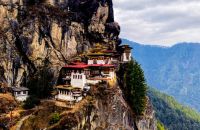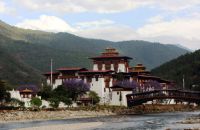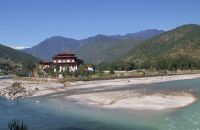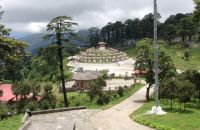Talk with our local travel specialist who can help organize your trip.
20 Fun facts about Bhutan
Bhutan is a land of mystique and enchantment in the Eastern Himalayas as you explore its unique culture and stunning landscapes. Discover the Kingdom where happiness is measured, where there's a rare sight — no traffic lights! Where there is a huge commitment to sustainable tourism and where vibrant festivities fill up the lunisolar calendar.
Check out these 20 fun facts about Bhutan to learn about its rich culture, unique traditions, and heritage before you visit the Land of the Thunder Dragon.
1. Gross National Happiness (GNH) emphasis

Bhutan is perhaps best known for its unique approach to measuring national prosperity through Gross National Happiness (GNH). The GNH, which was initiated in 1970s, is measured on spiritual, physical, and mental well-being.This greatly indicates its priority for people's happiness rather than economic standards.
The GNH was measured at 0.781 in 2022 and sawan increase over the years despite the effects of pandemic. Bhutan is setting itself apart in its pursuit of holistic development, which is only made easier by the awe-inspiring landscape, spiritual monuments, and deep-rooted religions and traditions. Travelers can easily spot the calm, soulfulness, and togetherness as they set foot in Bhutan.
2. No traffic lights in Thimphu
Another surprising fact about Bhutan is that its capital city, Thimphu, stands without any traffic lights. There are only a handful of cities in the world without traffic lights, and Thimphu has been a prime example of how they can be managed. It was found that Bhutanese people preferred the direction of traffic policemen in the city. Hence, the lights were removed.
Despite having no traffic lights, there are few instances of congestion, as the now-famous traffic police vigilantly manage it. Surprisingly, while over 20 thousand vehicles hit the road daily in the city, there are no accidents, which shows the discipline of the Bhutanese people.
3. Archery as the national sport

If you come to Bhutan, you have to experience the thrill of holding a bow and arrow to hit the target. Archery isn't just a sport it's deeply ingrained in the national identity of Bhutan. Acknowledged as a sport since 1971, archery has a rich history and wide spread popularity.
Don't be boggled if the locals call it "Da" the traditional name. Traditional archery is played in Bhutan, with participants wearing colorful attire, spirited cheering, and celebrating together.Tourists can enjoy archery matches regularly, but it is even better if you make it just in time to enjoy the grand Yangphel Open Archery Tournament
4. Traditional dress: 'kira' for women, 'gho' for men

The threads of tradition are woven perfectly by Bhutan's distinctive dress-Kira and Gho, which reflects the rich cultural heritage of the Kingdom.
Women are seen gracefully draped in the 'Kira' dress, made typically from finely woven fabric with intricate and vibrant patterns. It comprises a blouse, skirt, and jacket coordinated carefully.
The threads of tradition are woven perfectly by Bhutan's distinctive dress-Kira and Gho, which reflects the rich cultural heritage of the Kingdom. Women are seen gracefully draped in the 'Kira' dress, made typically from finely woven fabric with intricate and vibrant patterns.
It comprises a blouse, skirt, and jacket coordinated carefully. 'Gho', on the other hand, is a knee-length robe that shows the traditional charm of a Bhutanese man. It is tied to the waist with a belt and complemented by knee-high socks and traditional leather shows.
It looks aesthetically pleasing and plays a significant role during festivals and day-to-day attire. Tourists can rent the clothes to try them out and click pictures for memories. The annual festivals are a great place to meet men and women following this timeless charm and respecting their culture.
5. Ema Datshi: Spicy chili and cheese dish

Tourists will be amazed by the unique Bhutanese cuisine, which is in the heart of the locals and will surprisingly leave the taste buds wondering. Ema Datshi is a fiery blend of spicy chilies, tangy cheese, and a flavorful thick stew. The bold combination of ingredients is all-natural and locally produced in Bhutan's hilly and Himalayan areas.
The dish is consumed daily but holds a special significance during festivals and celebrations. There are variations of Ema Datshi with additions of onions, mushrooms, and more, but eating the authentic stew in the cold weather is an amazing experience.
6. Taktshang Monastery (Tiger's Nest)

Bhutan is known widely for its iconic Tiger's Nest monastery perched in the clouds. Also known as the Taktshang monastery, it is an architectural marvel and a spiritual beacon in Bhutan. Sitting at a cliff of 3180m in the Paro Valley, the monastery is a testament to Bhutanese crafts manship and devotion. An interesting folklore about the monastery is that Guru Rinpoche,known as the "Second Buddha," flew to this location on the back of a tigress, meditating in a cave that later became the heart of Taktshang.
Tourists flock to witness this marvel by taking a 2 hours hike through a pine forest. There are four main complexes in the monastery and a large prayer wheel. The serenity, fresh air, and fluttering of the prayer flags make up for a spiritual journey.
7. Sustainable tourism initiatives
Something unique about Bhutan is its commitment to "high value, low impact" tourism. Integral to the preservation of its natural and heritage sites, it is exemplified through the Sustainable Development Fee (SDF). In an impressive move towards fostering sustainable tourism, Bhutan has restructured its SDF framework since September 2023 to be followed until September 2027.The commitment man dates an SDF of $100 per night per person for any tourists in Bhutan
The fee is utilized to regulate tourism initiatives and protect Bhutan's ecosystem. It ensures that each visitor contributes meaningfully to the conservation of Bhutan's unique cultural and environmental heritage.
8. Phallus symbols in temples
Many tourists might find this fun fact equally amusing. The Bhutanese people symbolize the phallus symbol to bring protection and fertility. It is known to protect the country and families from negativity or evil. Hence, you will witness these whimsical symbols in ancient temples,most not ably Chimi Lhakhang temple, known as the fertility temple.
Locals and tourists visit the temple to take blessings for fertility. The temple was built in 1499 by Drukpa Kunley, known as the Divine Madman-a Buddhist saint. His unorthodox methods and teachings can be seen in phallic symbols drawn as paintings and carvings on walls and doors ofthe temple. It is a must-visit place to witness the Bhutanese tradition and play fulness harmoniously co-exist.
9. Traditional Bhutanese architecture
Tradition and art come together in the Bhutanese architectural monuments, monasteries, and Dzongs. The country has thousands of monuments, dzongs, temples, and monasteries, which testify to the Kingdom's commitment to preserving its cultural heritage. The architecture is madefrom locally sourced materials like stone, mud, timber, and fabric. The embellishments of dragonmotifs, auspicious symbols, and different forms of Buddha all have spiritual meanings.
You can witness this unique architecture in Paro Taktsang, Punakha Dzong, the tall Buddha Dordema statue, Gangtey Monastery, Trongsa Dzong, and more. These have a rich history of the wars won, Buddha's teachings, and respect for the Kings and Queens of Bhutan.
10. Abundance of Festivals and celebrations
An interesting aspect of Bhutan is that there is an abundance of festivals spanning more than 25 that are celebrated annually. With the calendar brimming with festivities, the Bhutanese people are always excited and get a chance to interact with the entire community. The communal joyand spiritual renewal express Bhutanese identity.
Festivals like Paro Tsechu and Thimphu Tsechu draw locals and tourists alike to celebrate elaborate rituals like fire displays, masked dances, mythical tails, prayers, and more. The vibrant costumes and rhythmic movements create a visual spectacle and symbolize protection from evil. Many events also call for a display by the royals of Bhutan, which adds to the excitement.
Tourists align their visit to Bhutan with festivities because it is the best time to interact with the locals and witness the culture and community spirit.
Featured Trips
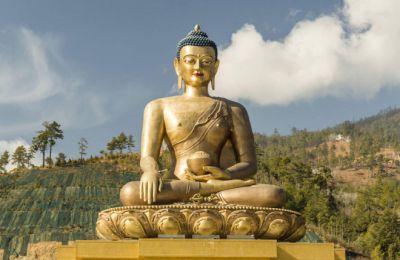
Bhutan Heritage Tour - 8 days
Bhutan Heritage Tour lets you explore centuries-old dzongs and Lakhangs built by Bhutanese kings and spiritual leaders. Take this Bhutan Heritage Tour and journey across the cultural hotspots of Bhutan, a fascinating Himalayan kingdom.
Inquire NowWhere to travel next?
Get help from our travel specialists for holiday ideas that matches your interests.
11. National animal: The Takin
Bhutan boasts a unique and exclusive national treasure—the Takin (Budorcas taxicolor) as its national animal. Takin is often dubbed the "gnu goat" and possesses a distinctive appearance with a robust body, short legs, and a peculiar snub nose.
Bhutan has established the Motithang Takin Preserve to protect and conserve this species. Thereserve, nestled in the Thimphu Valley, provides a sanctuary for the Takin to roam freely amidst lush landscapes. Considered globally vulnerable, the Takin has seen an increase in population in Bhutan after the protection initiatives. The Takin's conservation status prompted the creationof the reserve, which was crucial in safe guarding this national symbol.
12. Unique calendar based on lunar and solar phases
It is amazing to see that the calendars world wide are so different. Bhutan, too, dances to the rhythm of a distinctive calendar, which is dictated by the lunar and solar phases. Unlike the conventional Gregorian calendar, Bhutan's calendar seamlessly merges the lunar and solar cycles, reflecting the Kingdom's spiritual and agricultural rhythms.
This unique calendar is intricately tied to Bhutanese traditions, guiding its religious ceremonies.A variation of the lunisolar Tibetan calendar means that the festivals, known as "tsechus," unfoldat different times from year to year. Bhutan celebrates its new year, known as "Lhosar," in the month of February or March, depending upon the calendar.
13. Only one international airport
Nestled amidst the towering Himalayas, Bhutan has a singular international gateway—the Paro International Airport! The airport is located in a unique setting surrounded by steep mountains.
With a single run way and the unpredictable Himalayan weather, landing at the Paro airport is afeat.Flights are limited, and weather conditions play a pivotal role in determining the feasibility of landings, contributing to the airport's exclusivity.
The breath taking descent into Paro shows the wonderful nature and the airport's challenging to pography.
14. Bhutanese folk music with traditional instruments
Bhutan is known distinctively for its ancient music and the use of traditional instruments. Their folk music is a melodic echo of the Kingdom's cultural richness, tradition, and story telling.Rooted in age-old customs, Bhutanese folk music employs an array of traditional instruments like the drangyen (lute), chiwang (fiddle), and yangchen (hammered dulcimer). Each contributes to the distinctive sound that encapsulates the spirit of Bhutan.
The songs are often accompanied by rhythmic dances, recounting tales of love, mythical heroes, Guru Rinpoche, spirituality, and the Kingdom's vibrant history.
Tourists are highly interested to hear the music sung, mostly during annual festivals and lively gatherings. Bhutan is preserving its unique identity by celebrating its heritage through the universal language of music.
Featured Trips
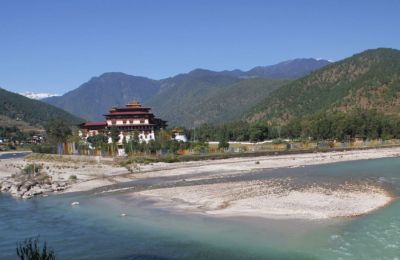
Bhutan Cultural Tour - 5 days
Bhutan Cultural Tour of 5 days lets you discover the rich Bhutanese culture. Visit ancient fortresses and Taktsang Monastery. Enjoy traditional hot stone bath.
Inquire NowWhere to travel next?
Get help from our travel specialists for holiday ideas that matches your interests.
15. Agriculture and rural life's significance
Agriculture and forestry make up almost 60% of the livelihood of the Bhutanese. Hence, Bhutanis often denoted by fertile fields and a terraced landscape, which defines its rural existence.Unlike the bustling pace of city life in other countries, Bhutanese locals find solace and purpose in the simplicity of agricultural traditions that shape their daily routines.
Upon visiting Bhutan, you can witness locals tending to fields, cultivating crops, and caring for live stock. The terraced fields of rice, barley, and potatoes thrive in abundance in this Himalayan land scape. Communal farming practices are still common, and you can witness roads leading through fields.
16. Emphasis on traditional medicine
Yet another interesting fact about Bhutan is that traditional medicine is, to date, widely practiced. Locals rely on an array of indigenous products, such as herbs, roots, animals, andminerals, to meticulously prepare to address a spectrum of ailments. Bhutanese traditional medicine, referred to as gSo-ba Rig-pa, stands as one of the world's oldest enduring medical traditions. Rooted in ancient wisdom, Sowa Rigpa translates to "The science of nourishment.
Bhutan has also invested in traditional medicine research centers. If it interests you, make sure to visit the Institute of Traditional Medicine Services in Thimphu, where you'll find the differenttime-honored healing practices being tested and refined.
Herbs and medicines like Artemisia (Thumche), Cordyceps sinensis (Yartsa Goenbub), Aconitum spicatum (Bikhma), and others are used for different purposes like treating digestive issues, respiratory issues, alleviating pain, and more. At present, there is a growing interest in sharing these remedies globally
17. National flag featuring a white dragon
Bhutan boasts a unique flag featuring a diagonally divided field of saffron and orange, with a white dragon centered along the dividing line. Everything in the flag holds a religious and cultural meaning. The color saffron represents the Drukpa Kagyu school of Buddhism, while orange signifies the country's secular authority.
The white dragon on the flag is symbolic of Bhutan's name, Druk Yul, which translating to the "Land of the Thunder Dragon. "The dragon, known as the "Druk," holds immense significance in Bhutanese mythology, representing thunder storms and the essence of the divine.
Spiritually and religiously, the Druk is associated with Bhutan's pre-dominant religion, Vajrayana Buddhism, symbolizing the protection of the country and its people.
The unique flag encapsulates the nation's rich cultural heritage and its harmonious blend of spirituality and secular governance.
18. National flower: The blue poppy
Interestingly, Bhutan's national flower is the elusive blue poppy (Meconopsis grandis). The flower is found in the high-altitude meadows of Bhutan's alpine region. Recognized for its delicate beauty, the blue poppy symbolizes purity, which is reflected in the country's pristineland scapes. Found in places like the Jomolhari Mountain, conservation efforts aim to preserveits habitat. Beyond the mountains, the blue poppy is also used in Bhutanese art and textiles, becoming a cultural emblem.
19. Constitutional monarchy since 2008.
Bhutan's history is unique to that of other nations as historically, the Kingdom was ruled by monarchs under the dual system of Chhoesi (religious) and Desi (secular) leadership. In 2008, Bhutan transitioned into a constitutional monarchy, marking a significant shift. The Fourth King,Jigme Singye Wangchuck, abdicated in favor of his son, Jigme Khesar Namgyel Wangchuck,who introduced a democratic constitution. The move was revolutionary, initiating the parliamentary elections and shifting powers to elected representatives.
The King is sought for his guidance and plays a ceremonial role, while the Prime Minister headsthe executive branch.
Hence, if you visit Bhutan, be sure to visit the royal residence, Punakha Dzong, which symbolizes the monarch's historical connection, and Thimphu, which serves as the administrative center. It displays Bhutan's harmonious blend of tradition and progressive governance.
- Written by: Naba Raj Amgai
Updated: Dec, 12, 2023

.jpegXkO.jpeg)

